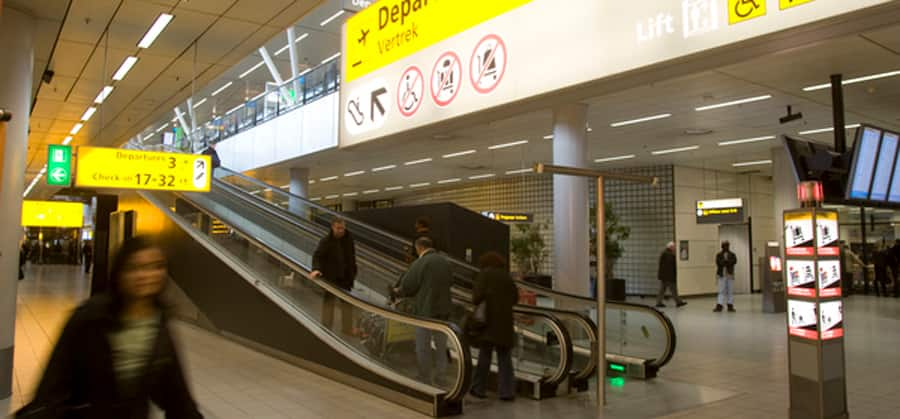Text: Payal Bhattar
Picture yourself at an airport a few years from now. Imagine an entertaining, exciting, user-friendly and convenient journey that seems to have been designed just for you. Multiply your imagination many-fold and what you have is a ‘smart airport’ of the future.
“The airports of the future will increasingly look like integrated shopping malls and entertainment centers where you come by airplane. While the main function of the airport will be to provide international logistics for people, it will also be about how much revenue they are able to generate in terms of the commercial services they offer. And that’s why the convenience of the traveler will be of utmost importance,” says Reino Hyvärinen, SVP & Head of Escalator business, KONE Escalators.
The convenience of the traveler is important because non-aeronautical revenues like shops, parking, car rentals, dining, hotels, etc. contribute significantly to the worldwide revenue of airports. According to Airports Council International (ACI) in 2015 alone, airports earned nearly 40% of their total worldwide revenues of $152 billion.
“Clearly we see an increased trend in digitalization to enable smarter airport infrastructure. The Internet of Things (IoT) allows better data information for passengers and is very important for the airport infrastructure team too. Every airport has thousands of people working in different areas of the airport like ticketing, luggage handling, safety & security, energy supply etc. Better information and better infrastructure will allow them to increase the overall performance of the systems,” explains Sascha Brozek, Senior Vice President & Head of KONE Major Projects.
On the money trail
Improving the performance of all systems is critical because airports have to find new and more efficient ways to keep their revenues going. According to reports, non-aeronautical airport revenues in major markets like America & Europe are now stagnating or declining. For instance, Aéroports de Paris, Frankfurt airport and Schiphol airport in Amsterdam, announced drops in spending per passenger in 2016 of around 4-8%. Revenues from car parks and rentals in North America & Europe are under threat due to apps like Uber, which makes travel by taxi more affordable.

This is where KONE plays a significant role through its smart people flow solutions. KONE works with many airports around the globe like Schiphol, Heathrow, Munich, Vienna Skylink, Los Angeles, La Guardia, Oslo, O’Hare, Hongqiao, Shenzhen & Beijing and successfully moves millions of people across global airports every day.
Reino Hyvärinen explains, “In the case of large airports which have millions of passengers per annum, even if you increase the time that they spend conveniently inside the airport shopping area for say 5 minutes, that already provides quite important additional revenues. In the case of regional airports, where the speed of travel is a top priority, KONE’s People Flow solutions can enable people from the gate to the taxi queue on average, within a 15 minute to 18-minute period.”
These solutions are essential because on the one hand, 67% of airports worldwide are still operating at net losses and on the other hand globalization, urbanization and economic growth are ensuring that the number of passengers traveling by air is growing by 4% annually. According to IATA, passengers traveling by air are likely to double from 3.8 billion in 2016 to 7.2 billion by 2035 driven primarily by growth in China & India.
Minimum delay, maximum spending
This high demand is driving the need for more efficient smart airport infrastructure, extensions, maintenance and repairs. Smart airports are eco-systems that integrate airlines, logistics, authorities and other vendors and partners in the airport management system via a digital grid. The digital grid is the nervous system that touches and manages every point of interaction via real-time exchange of information, process integration and advanced security. Smart airports enrich and personalize passenger experiences and anticipate the services people require, based on data exchange and analytics.
“Good People flow does not come by itself, but requires solid analysis and planning the most efficient routes, minimizing unplanned stops and understanding the required ‘People Flow’ capacities. This obviously opens many opportunities for companies like KONE to work with our infrastructure customers from planning, design to project delivery and maintenance. KONE’s advanced people flow services, combined with top of the line elevators, escalators and automatic doors, offer the optimal solutions for all requirements”, says Sascha Brozek.
Many airports have already begun offering smart services like smart robots, self-check-in kiosks, beacon services, real-time navigation within the airport via mobile phones, predictive analysis, automated parking facilities, indoor wayfinding, border control automation solutions and nearby promotional offers, based on data collected regarding the passengers' spending and usage habits. The global smart airport market is expected to grow at a CAGR of 10.7% and reach USD 25.09 billion by 2025.
Experience is everything
KONE is designing and planning the journey of the traveler from the taxi or the public transportation location to the airport gate and back as conveniently as possible using a variety of solutions. Some of these unique solutions include voice guidance services for the elderly and handicapped people and inputs for passengers related to different services inside the airports which are available on their hand-held devices by voice or other means.
KONE’s rich experience in developing and analyzing the flow of people in various buildings has helped in knowing how to move people conveniently inside large destination hubs. This gives them great insight into end-users and their journeys in airports and also the ability to service the needs of customers (builders & operators etc.) through the lifecycle of the airport.
The key now is to make the journey from one airport to another smarter, faster and better - because the experience is everything.
